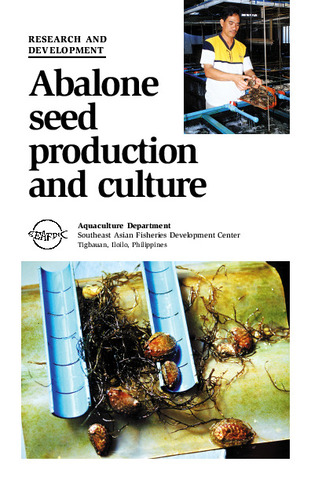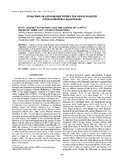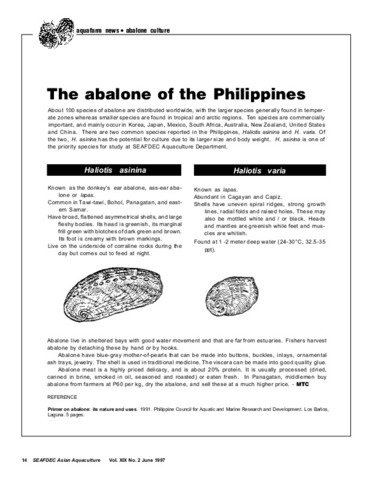| dc.contributor.author | Lebata-Ramos, Ma. Junemie Hazel | |
| dc.contributor.author | Doyola-Solis, Ellen Flor C. | |
| dc.contributor.author | Abrogueña, Jeff Bogart R. | |
| dc.contributor.author | Ogata, Hiroshi | |
| dc.contributor.author | Sumbing, Joemel G. | |
| dc.contributor.author | Sibonga, Rema | |
| dc.date.accessioned | 2015-05-20T07:07:07Z | |
| dc.date.available | 2015-05-20T07:07:07Z | |
| dc.date.issued | 2013 | |
| dc.identifier.citation | Lebata-Ramos, M. J. H., Doyola-Solis, E. F. C., Abrogueña, J. B. R., Ogata, H., Sumbing, J. G., & Sibonga, R. C. (2013). Evaluation of post-release behavior, recapture, and growth rates of hatchery-reared abalone Haliotis asinina released in Sagay Marine Reserve, Philippines. Reviews in Fisheries Science, 21(3-4), 433-440. | en |
| dc.identifier.issn | 1064-1262 | |
| dc.identifier.uri | http://hdl.handle.net/10862/2235 | |
| dc.description.abstract | The lucrative returns brought by abalone fisheries have caused overexploitation and decline of the wild population. In the Philippines, the Aquaculture Department of the Southeast Asian Fisheries Development Center has successfully produced Haliotis asinina seeds in the hatchery. Aside from utilizing these seeds in aquaculture, they are also being considered for future stock enhancement endeavors of the department. This study aimed to evaluate post release behavior, recapture and growth rates of hatchery-reared abalone juveniles released in the Sagay Marine Reserve. From the two release trials conducted, results showed that abalone of shell length >3.0 cm had lower mortality during onsite acclimation and utilized transport modules as temporary shelter for a shorter period after release. Both wild and hatchery-reared abalone preferred dead branching corals with encrusting algae as their habitat. Recapture rates were comparable between the wild (7.97%) and hatchery-reared (HR2) abalone (6.47%). Monthly growth rates were almost the same between wild (0.25 cm, 4.0 g), hatchery-reared (HR1: 0.27 cm, 4.6 g; HR2: 0.35 cm, 3.8 g) abalone. Moreover, hatchery-reared abalone were recaptured up to 513 days post-release, indicating viability of released stocks in the wild. Results of releases revealed that hatchery-reared abalone can grow and survive with their wild conspecifics. | en |
| dc.language.iso | en | en |
| dc.publisher | Taylor & Francis | en |
| dc.subject | Haliotis | en |
| dc.subject | Haliotis asinina | en |
| dc.subject | Philippines | en |
| dc.title | Evaluation of post-release behavior, recapture, and growth rates of hatchery-reared abalone Haliotis asinina released in Sagay Marine Reserve, Philippines | en |
| dc.type | Article | en |
| dc.citation.volume | 21 | |
| dc.citation.issue | 3-4 | |
| dc.citation.spage | 433 | |
| dc.citation.epage | 440 | |
| dc.citation.journalTitle | Reviews in Fisheries Science | en |
| dc.subject.asfa | acclimatization | en |
| dc.subject.asfa | Algae | en |
| dc.subject.asfa | aquaculture | en |
| dc.subject.asfa | species | en |
| dc.subject.asfa | corals | en |
| dc.subject.asfa | fisheries | en |
| dc.subject.asfa | gastropod fisheries | en |
| dc.subject.asfa | growth rate | en |
| dc.subject.asfa | habitats | en |
| dc.subject.asfa | hatcheries | en |
| dc.subject.asfa | mariculture | en |
| dc.subject.asfa | marine parks | en |
| dc.subject.asfa | mollusc culture | en |
| dc.subject.asfa | mortality | en |
| dc.subject.asfa | mortality causes | en |
| dc.subject.asfa | seeds | en |
| dc.subject.asfa | shellfish culture | en |
| dc.subject.asfa | shells | en |
| dc.subject.asfa | shelters | en |
| dc.identifier.essn | 1547-6553 | |
| dc.identifier.doi | 10.1080/10641262.2013.836445 | |



